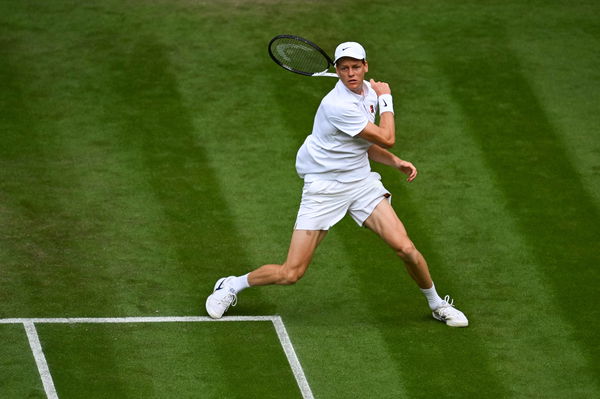
Imago
Tennis : Wimbledon -2025 – ITF – Tennis – Wimbledon – ITF – Jannik Sinner – Italie GB PUBLICATIONxNOTxINxFRAxBEL Copyright: xChryslenexCaillaudx/xPznewzx

Imago
Tennis : Wimbledon -2025 – ITF – Tennis – Wimbledon – ITF – Jannik Sinner – Italie GB PUBLICATIONxNOTxINxFRAxBEL Copyright: xChryslenexCaillaudx/xPznewzx
Although Jannik Sinner has been one of the most successful players on the ATP Tour over the last couple of years, things haven’t gone his way completely this year. The Italian star was suspended for three months by the World Anti-Doping Agency after he tested positive for a banned substance. Even though Sinner maintained his innocence in this matter, the anti-doping rules make for strict action after testing positive. But how did Sinner’s case unfold?
Watch What’s Trending Now!
It all began after the Indian Wells Masters when Sinner’s blood sample was found to contain Clostebol, a substance banned by the WADA. The World Number 1 came in contact with it through a spray applied by his physio. Although Sinner’s case was deemed as “no fault or negligence” by the ITIA, WADA made an appeal to the CAS, which carried the case forward. Eventually, Sinner reached an agreement with the agency and accepted a 3-month ban after the Australian Open this year.
However, the news about Sinner failing the doping test was only made public before the US Open last year, almost five months after he tested positive. This caused quite a stir in the tennis circle, with many bigwigs questioning the transparency in this case. Although Sinner was cleared by the ITIA initially, he was stripped of his ranking points and prize money earned from the Indian Wells Masters. Meanwhile, Sinner parted ways with physiotherapist Naldi and fitness trainer Ferrara, who were involved in this doping fiasco.
ADVERTISEMENT

Imago
2025 Wimbledon Jannik Sinner ITA 2025 Wimbledon *** 2025 Wimbledon Jannik Sinner ITA 2025 Wimbledon
Initially, WADA pushed for Sinner to be banned for at least one or two years and filed an appeal in the Court of Arbitration for Sport. The hearing was scheduled for April this year, but the two parties reached a mutual agreement, with Sinner accepting a 3-month suspension from the sport. This period started after the Australian Open this year and ended before the French Open.
ADVERTISEMENT
What did Jannik Sinner say about his doping case?
Throughout the doping saga, Sinner maintained his innocence and bore no fault of his own. However, it was his team that let him down, and Sinner bore the brunt of it. While reaching an agreement with WADA, Sinner revealed, “This case had been hanging over me for nearly a year and the process still had a long time to run with a decision maybe only at the end of the year.”
Further, he went on to add, “I have always accepted that I am responsible for my team and realise Wada’s strict rules are an important protection for the sport I love. On that basis I have accepted Wada’s offer to resolve these proceedings on the basis of a three-month sanction.”
ADVERTISEMENT
Despite the doping fiasco, it had no bearing on Sinner’s results on the court. He went on to win the US Open last year and the Australian Open this year, apart from other wins on the ATP Tour. Moreover, he also reached the summit clash of the French Open and is looking to win his maiden title at Wimbledon this year. Sinner defeated Novak Djokovic today and set up a clash with Carlos Alcaraz in the Wimbledon finals. Check out EssentiallySports’ minute by minute update of the Championships on our Live Blog.
ADVERTISEMENT
ADVERTISEMENT
ADVERTISEMENT

